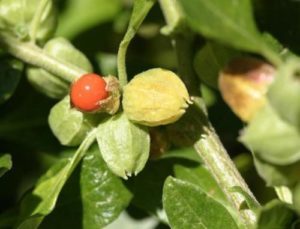#indian_ginseng
Text
herbs, #anxiety, #adaptogens, #ashwagandha, #bufera, #indian_ginseng, #oroval, #orval, #nightshade, #chamomile, #valerian, #sleep, #anxiety, #depression, #lavender, #nerves, #tempazcolole, #tranquilizer, #passionflower, #restlessness, #nervousness, #anxiety, #kava, #cannabidiol, #sleep, #l_lysine, #l_arginine, #magnesium, #vitaminC, #recipes, #healthy, #healthyrecipes, #recetas, #saludables, #recetasaludables,
3 notes
·
View notes
Text
Ashwagandha (Withania Somnifera)

Withania somnifera, commonly known as Ashwagandha means "horse like smell" in Sanskrit. This herb has an important history and has been used since the past 300 years. Its medical values are also mentioned in Ayurveda. Ashwagandha is mentioned as "adaptogen" in ayurveda since it improves physical energies along with the athletic abilities of the person consuming it. Withania Somnifera is often used as gentle tonic for the nervous system.

Scientific Classification
Kingdom - Plantae
Subkingdom - Tracheobionta (Vascular plant)
Superdivision - Spermatophyta (Seed plant)
Division - Magnoliophyta (Flowering plant)
Class - Magnoliopsida (Dicotyledons)
Subclass - Asteridae
Order - Solanales
Family - Solanaceae (potato family) or Nightshade family
Genus - Withania Pauquy
Species - Withania somnifera Dunal
Scientific name - Withania somnifera
Botanical Description

Ashwagandha is a low growing perennial shrub with star shaped branches extending radially from a central stem. Ashwangandha is covered with fine, densely matted wooly hairs (tomentose). This plant grows short and upright upto a height of 35 to 75 cm having dull green color elliptic leaves. The leaves of ashwagandha grow 10 to 12 cm long and 5 cm wide. The flowers of this herb are small, bell shaped, hermaphrodites (having both male and female organs) with yellow petals on the inside and a green outer covering layer. The roots of this plant look like long whitish brown fleshy tubers. Ashwagandha is a small woody shrub that blooms throughout the year, and has fruits in a papery protective covering calyx. The fruit is orange or red in colour, which when ripe, looks like a cherry. This is the reason why ashwagandha is also known as winter cherry. This herb produces kidney shaped seeds of yellow color.
Origin and Distribution of Ashwagandha
Ashwagandha is native to India but the plant is now grown in all parts of the word, due to its medicinal value and benefits. It is also found in Nepal, China and Yemen.
Favorable Conditions for Growing Ashwagandha
Soil : Ashwagandha needs sandy and well-drained soil through which water can

drain out quickly. The pH level of the soil should be around 7.5 – 8 viz the soil should be neutral or very less, alkaline. Growing ashwagandha is not possible in soil that retains moisture and remains waterlogged.
Sun : Ashwagandha grows best when the temperature range is between 70° F to 95° F (20°C to 35° C). In temperatures below or above this, the growth of ashwagandha is very slow and dull.
Water : You can water this herb only when the plant seems thirsty because Indian ginseng is a drought resistant herb and it does not like wet feet. So beware, too much watering can damage the roots of the plant, increasing the chances of root rot.
Spacing : For ashwagandha cultivation you need to plant the seeds, 2 cm deep and 10 cm apart. Thin out the weak plants after a month, leaving a space of around 50 – 60 cm between the plants.
Companion Planting : Ashwagandha can be planted along side any plant as it is a great companion plant.
Ashwagandha can be planted alongside Tomatoes, Basil, Geraniums, Marjoram, Petunia and Okra
Read the full article
2 notes
·
View notes
Photo

There are many benefits to buying Ashwagandha supplements online and Reformgsa.com is your one stop shop to learn about dosage, pill size and the definition of Ashwagandha. Some of the main benefits of Ashwagandha include reduced stress, anxiety and increased brain function. Also known as Indian Ginseng.
0 notes